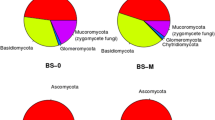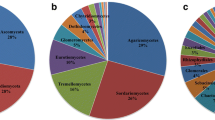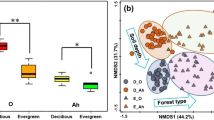Abstract
Plant diversity is considered one factor structuring soil fungal communities because the diversity of compounds in leaf litter might determine the extent of resource heterogeneity for decomposer communities. Lowland tropical rain forests have the highest plant diversity per area of any biome. Since fungi are responsible for much of the decomposition occurring in forest soils, understanding the factors that structure fungi in tropical forests may provide valuable insight for predicting changes in global carbon and nitrogen fluxes. To test the role of plant diversity in shaping fungal community structure and function, soil (0–20 cm) and leaf litter (O horizons) were collected from six established 1-ha forest census plots across a natural plant diversity gradient on the Isthmus of Panama. We used 454 pyrosequencing and phospholipid fatty acid analysis to evaluate correlations between microbial community composition, precipitation, soil nutrients, and plant richness. In soil, the number of fungal taxa increased significantly with increasing mean annual precipitation, but not with plant richness. There were no correlations between fungal communities in leaf litter and plant diversity or precipitation, and fungal communities were found to be compositionally distinct between soil and leaf litter. To directly test for effects of plant species richness on fungal diversity and function, we experimentally re-created litter diversity gradients in litter bags with 1, 25, and 50 species of litter. After 6 months, we found a significant effect of litter diversity on decomposition rate between one and 25 species of leaf litter. However, fungal richness did not track plant species richness. Although studies in a broader range of sites is required, these results suggest that precipitation may be a more important factor than plant diversity or soil nutrient status in structuring tropical forest soil fungal communities.




Similar content being viewed by others
References
Hattenschwiler S, Tiunov AV, Scheu S (2005) Biodiversity and litter decomposition in terrestrial ecosystems. Annu Rev Ecol Evol Syst 36:191–218
McGuire KL, Zak DR, Edwards IP, Blackwood CB, Upchurch R (2010) Slowed decomposition is biotically mediated in an ectomycorrhizal, tropical rain forest. Oecologia 164:785–795
Peay KG, Kennedy PG, Davies SJ, Tan S, Bruns TD (2010) Potential link between plant and fungal distributions in a dipterocarp rainforest: community and phylogenetic structure of tropical ectomycorrhizal fungi across a plant and soil ecotone. New Phytol 185:529–542
Tedersoo L, Nilsson RH, Abarenkov K, Jairus T, Sadam A, Saar I, Bahram M, Bechem E, Chuyong G, Koljalg U (2010) 454 Pyrosequencing and Sanger sequencing of tropical mycorrhizal fungi provide similar results but reveal substantial methodological biases. New Phytol 188:291–301
Fierer N, Jackson RB (2006) The diversity and biogeography of soil bacterial communities. Proc Natl Acad Sci U S A 103:626–631
Watling R (2001) The relationships and possible distributional patterns of boletes in South-East Asia. Mycol Res 105:1440–1448
Lindblad I (2001) Diversity of poroid and some corticoid wood-inhabiting fungi along the rainfall gradient in tropical forests, Costa Rica. J Trop Ecol 17:353–369
Lodge DJ (1997) Factors related to diversity of decomposer fungi in tropical forests. Biodivers Conserv 6:681–688
Buee M, Reich M, Murat C, Morin E, Nilsson RH, Uroz S, Martin F (2009) 454 Pyrosequencing analyses of forest soils reveal an unexpectedly high fungal diversity. New Phytol 184:449–456
Taylor DL, Herriott IC, Stone KE, McFarland JW, Booth MG, Leigh MB (2010) Structure and resilience of fungal communities in Alaskan boreal forest soils. Can J For Res-Rev Can Rech For 40:1288–1301
O’Brien HE, Parrent JL, Jackson JA, Moncalvo JM, Vilgalys R (2005) Fungal community analysis by large-scale sequencing of environmental samples. Appl Environ Microbiol 71:5544–5550
Powers JS, Montgomery RA, Adair EC, Brearley FQ, DeWalt SJ, Castanho CT, Chave J, Deinert E, Ganzhorn JU, Gilbert ME, Gonzalez-Iturbe JA, Bunyavejchewin S, Grau HR, Harms KE, Hiremath A, Iriarte-Vivar S, Manzane E, de Oliveira AA, Poorter L, Ramanamanjato JB, Salk C, Varela A, Weiblen GD, Lerdau MT (2009) Decomposition in tropical forests: a pan-tropical study of the effects of litter type, litter placement and mesofaunal exclusion across a precipitation gradient. J Ecol 97:801–811
Gentry AH (1992) Tropical forest biodiversity—distributional patterns and their conservational significance. Oikos 63:19–28
Valencia RH, Balslev H, Paz H, Mino CG (1994) High tree alpha-diversity in Amazonian Ecuador. Biodivers Conserv 3:21–28
Aerts R (1997) Climate, leaf litter chemistry and leaf litter decomposition in terrestrial ecosystems: a triangular relationship. Oikos 79:439–449
Couteaux MM, Bottner P, Berg B (1995) Litter decomposition, climate and litter quality. Trends Ecol Evol 10:63–66
Perez-Harguindeguy N, Diaz S, Cornelissen JHC, Vendramini F, Cabido M, Castellanos A (2000) Chemistry and toughness predict leaf litter decomposition rates over a wide spectrum of functional types and taxa in central Argentina. Plant Soil 218:21–30
Sariyildiz T, Anderson JM (2002) Interactions between litter quality, decomposition and soil fertility: a laboratory study. Soil Biol Biochem 35:391–399
Berg B, McClaugherty C (2003) Plant litter: decomposition, humus formation, carbon sequestration. Springer, Berlin
McGuire KL, Bent E, Borneman J, Majumder A, Allison SD, Treseder KK (2010) Functional diversity in resource use by fungi. Ecology. doi:10.1890/09-0654
Hanson CA, Allison SD, Bradford MA, Wallenstein MD, Treseder KK (2008) Fungal taxa target different carbon sources in forest soil. Ecosystems 11:1157–1167
Boddy L (1999) Saprotrophic cord-forming fungi: meeting the challenge of heterogeneous environments. Mycologia 91:13–32
Dickie IA, Xu B, Koide RT (2002) Vertical niche differentiation of ectomycorrhizal hyphae in soil as shown by T-RFLP analysis. New Phytol 156:527–535
Genney DR, Anderson IC, Alexander IJ (2006) Fine-scale distribution of pine ectomycorrhizas and their extramatrical mycelium. New Phytol 170:381–390
Hooper DU, Chapin FS, Ewel JJ, Hector A, Inchausti P, Lavorel S, Lawton JH, Lodge DM, Loreau M, Naeem S, Schmid B, Setala H, Symstad AJ, Vandermeer J, Wardle DA (2005) Effects of biodiversity on ecosystem functioning: a consensus of current knowledge. Ecol Monogr 75:3–35
Jonsson LM, Nilsson MC, Wardle DA, Zackrisson O (2001) Context dependent effects of ectomycorrhizal species richness on tree seedling productivity. Oikos 93:353–364
Carney KM, Matson PA (2006) The influence of tropical plant diversity and composition on soil microbial communities. Microb Ecol 52:226–238
Waldrop MP, Balser TC, Firestone MK (2000) Linking microbial community composition to function in a tropical soil. Soil Biol Biochem 32:1837–1846
Ushio M, Wagai R, Balser TC, Litayama L (2008) Variations in the soil microbial community composition of a tropical montane forest ecosystem: does tree species matter? Soil Biol Biochem 40:2699–2702
Pyke CR, Condit R, Aguilar S, Lao S (2001) Floristic composition across a climatic gradient in a neotropical lowland forest. J Veg Sci 12:553–566
Turner BL, Romero TE (2009) Short-term changes in extractable inorganic nutrients during storage of tropical rain forest soils. Soil Sci Soc Am J 73:1972–1979
Leigh EG, Loo de Lao S, Condit R, Hubbell SP, Foster RB, Pérez R (2004) Barro Colorado Island forest dynamics plot, Panama. In: Losos EC, Leigh EG (eds) Tropical forest diversity and dynamism: findings from a large-scale plot network. The University of Chicago Press, Chicago, pp 451–463
Dieter D, Elsenbeer H, Turner BL (2010) Phosphorus fractionation in lowland tropical rainforest soils in central Panama. Catena 82:118–125
Feinstein LM, Sul WJ, Blackwood CB (2009) Assessment of bias associated with incomplete extraction of microbial DNA from soil. Appl Environ Microbiol 75:5428–5433
Borneman J, Hartin RJ (2000) PCR primers that amplify fungal rRNA genes from environmental samples. Appl Environ Microbiol 66:4356–4360
Fierer N, Hamady M, Lauber CL, Knight R (2008) The influence of sex, handedness, and washing on the diversity of hand surface bacteria. Proc Natl Acad Sci U S A 105:17994–17999
Lauber CL, Hamady M, Knight R, Fierer N (2009) Pyrosequencing-based assessment of soil pH as a predictor of soil bacterial community structure at the continental scale. Appl Environ Microbiol 75:5111–5120
Hamady M, Walker JJ, Harris JK, Gold NJ, Knight R (2008) Error-correcting barcoded primers for pyrosequencing hundreds of samples in multiplex. Nat Methods 5:235–237
Rousk J, Baath E, Brookes PC, Lauber CL, Lozupone C, Caporaso JG, Knight R, Fierer N (2010) Soil bacterial and fungal communities across a pH gradient in an arable soil. ISME J 4:1340–1351
Caporaso JG, Kuczynski J, Stombaugh J, Bittinger K, Bushman FD, Costello EK, Fierer N, Pena AG, Goodrich JK, Gordon JI, Huttley GA, Kelley ST, Knights D, Koenig JE, Ley RE, Lozupone CA, McDonald D, Muegge BD, Pirrung M, Reeder J, Sevinsky JR, Tumbaugh PJ, Walters WA, Widmann J, Yatsunenko T, Zaneveld J, Knight R (2010) QIIME allows analysis of high-throughput community sequencing data. Nat Methods 7:335–336
Allison SD, McGuire KL, Treseder KK (2010) Resistance of microbial and soil properties to warming treatment seven years after boreal fire. Soil Biol Biochem 42:1872–1878
Price MN, Dehal PS, Arkin AP (2009) FastTree: computing large minimum evolution trees with profiles instead of a distance matrix. Mol Biol Evol 26:1641–1650
Pruesse E, Quast C, Knittel K, Fuchs BM, Ludwig WG, Peplies J, Glockner FO (2007) SILVA: a comprehensive online resource for quality checked and aligned ribosomal RNA sequence data compatible with ARB. Nucleic Acids Res 35:7188–7196
White DC, Stair JO, Ringelberg DB (1997) Quantitative comparisons of in situ microbial biodiversity by signature biomarker analysis. J Ind Microbiol 17:185–196
Bligh EG, Dyer WJ (1954) A rapid method of total lipid extraction and purification. Can J Biochem Physiol 37:911–917
Zelles L (1999) Fatty acid patterns of phospholipids and lipopolysaccharides in the characterisation of microbial communities in soil: a review. Biol Fertil Soils 29:111–129
van Diepen LTA, Lilleskov EA, Pregitzer KS, Miller RM (2007) Decline of arbuscular mycorrhizal fungi in northern hardwood forests exposed to chronic nitrogen additions. New Phytol 176:175–183
Olsson PA (1999) Signature fatty acids provide tools for determination of the distribution and interactions of mycorrhizal fungi in soil. FEMS Microbiol Ecol 29:303–310
Gartner TB, Cardon ZG (2004) Decomposition dynamics in mixed-species leaf litter. Oikos 104:230–246
Chapman SK, Newman GS (2010) Biodiversity at the plant–soil interface: microbial abundance and community structure respond to litter mixing. Oecologia 162:763–769
Andren O, Balandreau J (1999) Biodiversity and soil functioning—from black box to can of worms? Appl Soil Ecol 13:105–108
Zak DR, Holmes WE, White DC, Peacock AD, Tilman D (2003) Plant diversity, soil microbial communities, and ecosystem function: are there any links? Ecology 84:2042–2050
Bell T, Newman JA, Silverman BW, Turner SL, Lilley AK (2005) The contribution of species richness and composition to bacterial services. Nature 436:1157–1160
Setala H, McLean MA (2004) Decomposition rate of organic substrates in relation to the species diversity of soil saprophytic fungi. Oecologia 139:98–107
Wohl DL, Arora S, Gladstone JR (2004) Functional redundancy supports biodiversity and ecosystem function in a closed and constant environment. Ecology 85:1534–1540
Meier CL, Bowman WD (2008) Links between plant litter chemistry, species diversity, and below-ground ecosystem function. Proc Natl Acad Sci U S A 105:19780–19785
Hawkes CV, Kivlin SN, Rocca JD, Huguet V, Thomsen MA, Suttle KB (2010) Fungal community responses to precipitation. Glob Chang Biol 17:1637–1645
Castro HF, Classen AT, Austin EE, Norby RJ, Schadt CW (2010) Soil microbial community responses to multiple experimental climate change drivers. Appl Environ Microbiol 76:999–1007
Baath E, Soderstrom B (1982) Seasonal and spatial variation in fungal biomass in a forest soil. Soil Biol Biochem 14:353–358
Trumbore S (2000) Age of soil organic matter and soil respiration: radiocarbon constraints on belowground C dynamics. Ecol Appl 10:399–411
Lindahl BD, Ihrmark K, Boberg J, Trumbore SE, Hogberg P, Stenlid J, Finlay RD (2007) Spatial separation of litter decomposition and mycorrhizal nitrogen uptake in a boreal forest. New Phytol 173:611–620
Fierer N, Schimel JP, Holden PA (2003) Variations in microbial community composition through two soil depth profiles. Soil Biol Biochem 35:167–176
Acknowledgments
We thank Joe Wright and Osvaldo Calderon for collection and identification of all litter species in the decomposition experiment. Collecting and export permits were granted from the Autoridad Nacional del Ambiente of Panama. Jenny Talbot and Angela Nguyen assisted with C and N measurements, and Steve Allison and Donovan German helped with extracellular enzyme assays and data interpretation. We also thank two anonymous reviewers for helping to improve the quality and clarity of the manuscript. This work was funded by NSF Ecosystems (DEB-0640666) and the Kearney Foundation.
Author information
Authors and Affiliations
Corresponding author
Rights and permissions
About this article
Cite this article
McGuire, K.L., Fierer, N., Bateman, C. et al. Fungal Community Composition in Neotropical Rain Forests: the Influence of Tree Diversity and Precipitation. Microb Ecol 63, 804–812 (2012). https://doi.org/10.1007/s00248-011-9973-x
Received:
Accepted:
Published:
Issue Date:
DOI: https://doi.org/10.1007/s00248-011-9973-x




